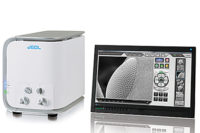Quality 101
Quality Control in a Digital World
Video borescopes can help improve inspection.

When evaluating an imaging solution for nondestructive testing applications that require a videoscope, it’s helpful to consider all elements of the imaging chain. Source: Karl Storz

Videoscope systems drive the quality, usability and reliability of internal feature inspection. Source: Karl Storz
Today, a quality inspection process is more critical than ever before. An emerging manufacturing renaissance in the United States has introduced a resurgence in product development and innovation. Increasing quality standards with respect to the tools used for visual analysis within nondestructive testing environments ensures reliable and consistent product quality, ultimately enabling manufacturing organizations to control costs associated with product defects that might otherwise not be identified.
Without these imaging systems, small diameter holes and optical limitations often dictate the use of high quality video borescopes (rigid or flexible with a camera attached) or videoscopes (with integrated imaging sensor) to support technician usability during a critical inspection process. An imaging system designed for an industrial environment is often required to capture and record video reference documentation and should support interoperability between various manufacturing processes.
When quality problems arise within a device manufacturing process, it’s important to be able to visualize, document and report on the defect or failure. In today’s digital media world, these images and videos are included in reports which are developed by suppliers and shared with customers of the manufacturer. The goal is to engage in a constructive dialogue for achieving better outcomes, reducing costs and improving overall efficiencies. This process is greatly improved when the imaging solution being utilized is a digital media centric device.
When evaluating an imaging solution for nondestructive testing applications that require a video borescope or videoscope it’s helpful to consider all elements of the imaging chain. Just as a professional photographer is interested in selecting the highest quality configuration of components to capture the relevant subject matter with the highest digital image quality, so too must the quality assurance technician or management within an organization when evaluating all the components of their industrial imaging chain.
Video borescope and videoscope systems with superior optical lens quality, camera image sensors and light-source drive the quality, usability and reliability of internal feature inspection. They all play a vital role in the part inspection quality process. Once the direction and angle of view is determined on the scope, the next question is what imaging documentation system can be utilized to image, illuminate, display and capture the information. The camera must be ergonomic enough for extended periods of use and versatile enough to work for different process-users and scopes. Still images and digital video files documenting inspection findings are becoming more prevalent within many industries and increasingly innovative quality management requires simplifying documentation workflow in these nondestructive visual inspection applications. This includes considerations ranging from ergonomic video cameras, integrated light sources, displays and capture systems that aid in the borescopic imaging environment and often do not require a computer interface. So what attributes should one look for when considering various components in an imaging chain?
Optics: quality optics equate to higher quality images and video and this digital media is what enables fine subtle details to be easily revealed and recognized by the technician’s eye.
Light source: Brighter and more efficient illumination expands what the operator can visualize.
High Resolution Color Display: A large ergonomic high resolution display presents image information that can be viewed by many and eliminates operator fatigue.
System Component Compatibility: Are all of the components compatible and designed to work seamlessly in order to ensure application flexibility and an intuitive user interface?
Many different imaging solutions are available on the market from many different suppliers. When considering an evaluation or investment in a digital nondestructive visual imaging system one should consider quality, cost of ownership and customer service to ensure a favorable ROI in today’s digital media world.
Looking for a reprint of this article?
From high-res PDFs to custom plaques, order your copy today!





